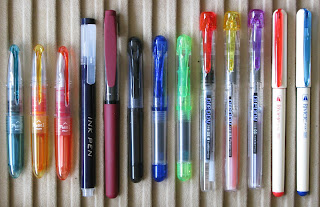On the other end there are a number of inexpensive pens. Unfortunately, they are often ignored. The picture shows a selection of these inexpensive pens. There might be many others—these I show I could buy them easily without going out of my way.
Starting from the left, the first three are Pilot Petit 1. The catalog price (MSRP) is JPY 315 including taxes. They are available in fourteen different colors in cartridges that are specific for these pens. No converter can be used on them. Very smooth writers.
Then comes the Sailor Ink Pen. This is available in 100-yen shop chain called Daiso. It uses Sailor cartridges and converters. The nib is not tipped and this makes it to write a bit like a stub. Smooth writer.
The long read and the short black have no brand other than “Produced for Daiso Japan”, written in both English and Japanese. These pens accept Sailor cartridges. The short one, however, does not have room for the converter.
Their quality is not consistent. The first one I tried was very smooth. But I lost it –big loss!— and the next one was a more deficient pen.
The short blue and green pens are basically the same as the black Daiso save for the detail of using international cartridges. This pen also comes in other colors—red, black. The price is the same —JPY 105—, and it can be found in some 100-yen shops other than Daiso.
The Platinum Preppy –here shown in red, yellow, and violet— costs JPY 210. It uses regular Platinum cartridges and converters. This pen's nib can be either F (0.3 mm) or M (0.5 mm). They are nice writers with very reliable flow, but not as smooth as the Petit 1. Their size, however, gives the Preppy a great advantage in terms of comfort.
With time, the cap develops some cracks making the pen impossible to close. Those unhappy with this problem can opt for the newly released Platinum Plaisir (as of July 2010)—same nib in an anodized aluminum body. Hopefully more durable, although the price is five times higher.
The last two pens are Platinum Riviere. These are available from Daiso shops for JPY 105. They have smooth M nibs, although different from those in the Preppy. These are on the dry side. Riviere uses Platinum cartridges and converters.
 Cheap pens in a 100-yen shop. From left to right: Platinum cartridges in red; Daiso's short pen (Mini); three Platinum Riviere in different colors; disposable pens in three colors; Daiso's full size pens in black and red; and red ink cartridges for these Daiso pens (Sailor compatible).
Cheap pens in a 100-yen shop. From left to right: Platinum cartridges in red; Daiso's short pen (Mini); three Platinum Riviere in different colors; disposable pens in three colors; Daiso's full size pens in black and red; and red ink cartridges for these Daiso pens (Sailor compatible). Sometimes I wonder… er... Well, I’ll leave it at this point.
Bruno Taut
(Inagi, July 3, 2010)
[labels: Pilot, Platinum, Sailor, Japón, Daiso]














































